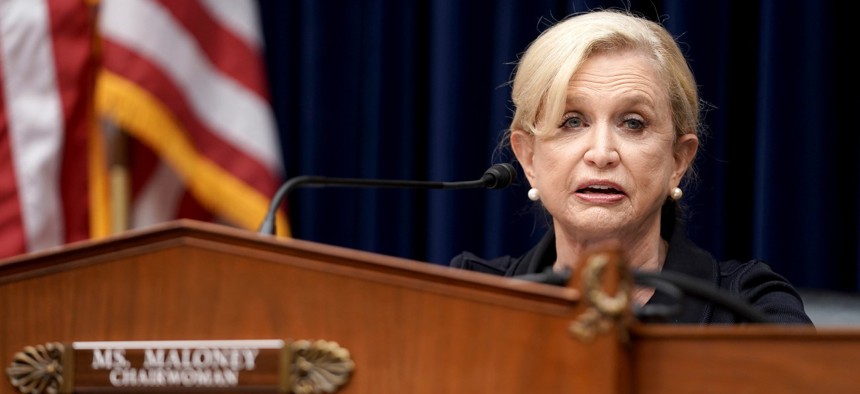
Rep. Carolyn Maloney, D-N.Y., introduced the bill. Greg Nash/Pool via AP
House Democrats Push for Expanded Paid Family Leave for Feds
A new bill would provide federal employees with 12 weeks of paid leave annually to care for themselves or a loved one, or in connection with a family member entering or returning from active military duty.
House Democrats announced Thursday that they will push to expand paid leave benefits for federal employees, hopeful that they can build on lawmakers' success in instituting a paid parental leave program two years ago.
House Oversight and Reform Committee Chairwoman Rep. Carolyn Maloney, D-N.Y., introduced the Comprehensive Paid Leave for Federal Employees Act, which would provide 12 weeks of paid leave each year to all federal workers, including employees of the legislative branch and the U.S. Postal Service, to deal with a personal illness, to care for a family member suffering from illness, or in connection with a family member going on or returning from active military duty.
“The truth is that many of us will have to deal with a family illness or care for an aging relative or need medical leave ourselves,” Maloney said in a call with reporters. “It’s not anything that you can plan for, but these are situations that we should be able to take care of without fear of losing a job or a paycheck . . . The federal government is the nation’s largest employer, and it should be a model employer that prioritizes family friendly policies.”
The bill’s provisions are similar to Maloney’s previous effort to provide paid leave to federal employees in 2019. That bill was included as a provision of the House’s version of the 2020 National Defense Authorization Act, but after resistance from Senate Republicans, it was trimmed down to only provide 12 weeks of paid leave coinciding with the birth, adoption or foster placement of a child. That program went into effect last October.
Rep. Gerry Connolly, D-Va., said the measure is important, given the federal government’s coming retirement crunch. With 31% of federal employees reaching retirement eligibility next year, agencies’ benefits packages must be able to compete with the private sector, he said.
“Many of the private sector companies we’re competing with already provide more family leave than the federal government, like Deloitte and Twitter, who each offer 16 weeks of paid family leave, which is all the more important as we’re in a pandemic,” he said. “We have a talent and recruitment challenge, and if we’re not providing the kinds of benefits available at private sector entities, we’ll have a lot of problems recruiting.”
American Federation of Government Employees National President Everett Kelley said that without access to paid family leave, “thousands” of his union’s members have been stretching themselves thin trying to work and care for loved ones.
“A member who has been a food safety inspector for over 20 years, her husband suffered a traumatic brain injury in 2017, leaving him significantly mentally and physically impaired,” Kelley said. “They recently learned that he will need [an amputation]. The bottom line is, he’ll need care, and 12 weeks of paid leave would help them avoid that impossible choice between getting him the care he needs and her doing her job.”
Calvin Harris, an employee at the Agriculture Department’s Food Nutrition Service and a member of the National Treasury Employees Union, said that he only very narrowly avoided having to tap into unpaid leave in the aftermath of a kidney transplant because the department shifted to maximum telework due to the COVID-19 pandemic.
“This cost a great deal of hardship for me, my family and my wife,” Harris said. “Right now I’m doing better, but it took every bit of about six months. As a matter of fact, after about eight weeks [after surgery] I had to return to work, but COVID-19 showed up, so with that I was able to continue to be out on telework along with my coworkers. But the reason I mention that is by that point, I was running out of sick and annual leave, and it took another six weeks before I really started feeling better.”







